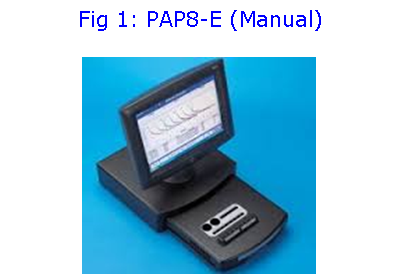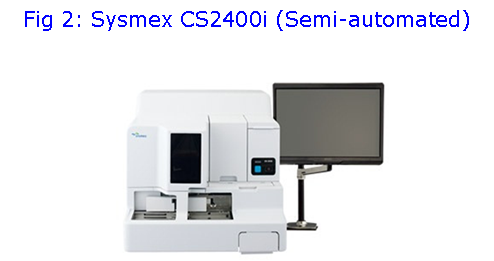Platelet Aggregometry Testing: A Potential Move Towards Semi-Automation
What are platelets & why are they important?
Platelets (also occasionally called thrombocytes) are tiny disc shaped components within the blood that assist in clot formation following damage to the inner lining (endothelium) of the blood vessels. The term platelet arose in the early 20th century following the observation that the structure was ‘plate like’. Although commonly termed a blood cell, mature platelets are not strictly cells as they contain no genetic material and are fragments of a parent cell.
Human platelets play a central role in primary haemostasis (the prevention of bleeding). Damage to the endothelial cells of the blood vessel invokes the release of potent stimulators of platelet activation. Activation of platelets results in a structural change from discoid to a larger shape of much greater surface area containing many cytoplasmic protrusions. The activated platelets adhere and aggregate forming a haemostatic plug that occludes the site of injury preventing further blood loss.
In addition to haemostasis, platelets play a role in inflammation and in the promotion of atherosclerosis and wound healing.
The different functions of platelets can be detected by a wide range of tests. Diagnosis of inherited or acquired platelet dysfunctions is required to identify patients at risk of bleeding.
What platelet tests are currently available?
Within Viapath’s Diagnostic Haemostasis and Thrombosis Laboratory, the tests of platelet function available include the platelet function assay (PFA) using the PFA-100; light transmission platelet aggregometry (LTRA) using the PAP8-E aggregometer, measurement of ATP release from platelet dense granules by lumiaggregometry using the Chrono-log analyser, quantitation of platelet nucleotides by luminescence and assessment of surface platelet glycoprotein expression by flow cytometry. The tests are used for the diagnosis of haemostatic disorders and managing patients with platelet and haemostatic defects.
What is platelet aggregometry?
Central to the diagnosis of platelet disorders is measurement of aggregation by light transmission aggregometry (LTRA) in response to specific platelet agonists. The agonists activate platelets via different mechanisms so that we can tell which area of function is compromised. LTRA allows for the diagnosis of specific receptor/pathway dysfunction by adding single agonists to platelet rich plasma in vitro and observing the aggregation in real time. Platelet aggregation in response to adenosine-diphosphate (ADP), arachidonic acid (AA), thrombin receptor activator peptide (TRAP), collagen, thromboxane analogue (U46619) and epinephrine (EPI) is routinely measured.
The platelet aggregometer works on the basic principle of light transmission. Platelet poor plasma (PPP) is prepared in parallel to platelet rich plasma (PRP) from each patient undergoing testing. Light transmission is set at 100% using PPP. PRP is set at 0% light transmission. As platelets aggregate in response to the agonist added, the light transmission of the sample increases. The nature and extent of aggregation is analysed and interpreted to record the presence of a specific platelet defect.
- Platelet rich plasma is produced using gentle centrifugation
- Sub-samples of platelet rich plasma are stirred in a cuvette between a light source and a photocell
- Agonist addition induces platelet shape change and aggregation
- Aggregation is viewed as an increase in light transmission
Current assay setup for LTRA within Diagnostic Haemostasis at Viapath
- LTRA is currently performed manually using the PAP8-E aggregometer.
- Platelets must be tested within 4 hours of collection as they are still ‘alive’.
- The maximum capacity on a given day is 3 patients and 1 control. Currently the assay is performed once a week.
- One member of staff is required for a full day to run LTRA. As the process is manual it is not possible to set up anything else simultaneously.
- The member of staff must be highly trained, only a limited number of staff can carry out the procedure.
- Experienced scientific and medical staff are required to interpret the complex result patterns.
Why is a semi-automated method required?
A semi-automated method would be expected to increase sample throughput and allow more members of the laboratory team to perform the procedure.
Outline of the study to compare manual versus semi-automated method of LTRA:
Viapath’s Diagnostic Haemostasis Laboratory is currently evaluating a semi-automated method of platelet aggregometry and comparing it with the current manual method. The methods are employed in parallel to assess consistency of results.
The evaluation aims to determine if the implementation of the Sysmex CS2400i platelet aggregometry method would increase the output of platelet testing, increase reliability and free up staff time. A further aim is to assess if staff find the method more user friendly.


Overview of the semi-automated method versus the manual method:
- The semi-automated method runs one sample at a time versus 3 patients and one control simultaneously via the manual method.
- Manual testing means patient phlebotomy must be co-ordinated; the semi-automated method should provide more flexibility and allow samples to be run consecutively.
- Agonists must be prepared manually for both methods. Once on board the analyser, agonists are added to the PRP automatically minimising operator input. Agonists are added manually to every tube of PRP using the current method.
- The semi-automated method does take extra time to perform a full panel of agonists compared to the manual method however the operator is free to perform other tasks during this time.
- Aggregation profiles cannot be viewed in real time using the semi-automated method and must be assessed after the run has finished. Decisions regarding repeat runs must be made at this time.
Expected outcomes of the evaluation
- To establish agreement between the current and new testing platform.
- To test how long the reagents remain stable on board the analyser.
- To check the lowest PRP count that will produce aggregation.
- To test how long PRP is viable for testing.
- To establish the maximum throughput of samples in a working day.
- To increase efficiency and throughput of platelet testing and provide more flexibililty to the clinicians and patients.
- The study is being conducted in collaboration with laboratories at St Barts and the London NHS Trust and Bristol University Hospitals Trust with a view to publishing the results and validating the method for use by the wider diagnostic community.
For more information about the automation of platelet aggregometry, please contact:
Dr. Áine McCormick: aine [dot] mccormick [at] viapath [dot] co [dot] uk

